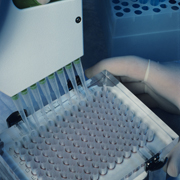Most women are familiar with the Pap smear—a cervical swab taken during routine pelvic exams to check for abnormal cells of cervical cancer.
Now a more high-tech test has been added to doctors’ diagnostic tools for cervical cancer. It detects DNA from the human papilloma virus (HPV), and some think this test will ultimately replace the 65-year-old Pap smear. Other medical researchers believe a combination of the two assays would provide the best approach to diagnose and treat cervical cancer at its earliest stages.
HPV, the primary cause of cervical cancer, is not one virus but many closely related subtypes often grouped by the different diseases they cause. When transmitted sexually, some HPV produce benign genitals warts or asymptomatic cervical infections that can resolve on their own without treatment. At least two HPV subtypes, identified as HPV-18 and HPV-16, possess the unique capacity to mutate normal cervical cells after infection and eventually transform them into cancer.
Authors from a Canadian study of more than 10,000 women found that the HPV test detected precancerous cervical lesions in 94.6% of the women with early cervical cancer compared to 55.4% of women detected by a Pap smear.
“The paper clearly comes across strongly in favor of HPV testing as a primary screening test,” says senior author Eduardo Franco, a cancer researcher at Montreal’s McGill University. If a women tests positive by HPV testing, then a follow up Pap smear or a more careful examination called a colposcopy would be recommended, write the authors.
HPV testing, with its increased sensitivity, might also allow women to be tested less frequently than traditional Pap smears—up to six years between tests instead of the usual two to three year intervals currently recommended for Pap smears by most physicians.
The HPV test picks up the presence of even the tiniest remnant of DNA of any HPV type, so the test is very sensitive. While not all women infected with HPV go on to develop cervical cancer, the presence of HPV-16 or HPV-18 subtypes does represent an increased risk for the disease.
As the HPV tests are refined and data from further studies unfolds, incorporating HPV testing into the standard care for women’s health will likely occur. Until then, HPV tests are approved only for women over 30 who have a questionable Pap smear or as a “co-test” done at the same time as the Pap smear at a physician’s request.
Article Links:
Mayrand, M., et al., Oct. 2007. “Human Papillomavirus DNA versus Papanicolaou Screening Tests for Cervical Cancer,” The New England Journal of Medicine.
http://content.nejm.org/cgi/content/abstract/357/16/1579
Rubin, R., 2007. USA Today article, “HPV Test More Accurate than Pap,”
http://www.usatoday.com/news/health/2007-10-17-hpv-pap_N.htm
Related Link:
OncoLink Website article, “Cervical Cancer: The Basics,” Abramson Cancer Center of the University of Pennsylvania, 2008. http://organizedwisdom.com/helpbar/index.html?return=http://organizedwisdom.com/Cervical_Cancer_and_Smoking&url=www.oncolink.org/types/article.cfm?c=6&s=17&ss=129&id=8226


